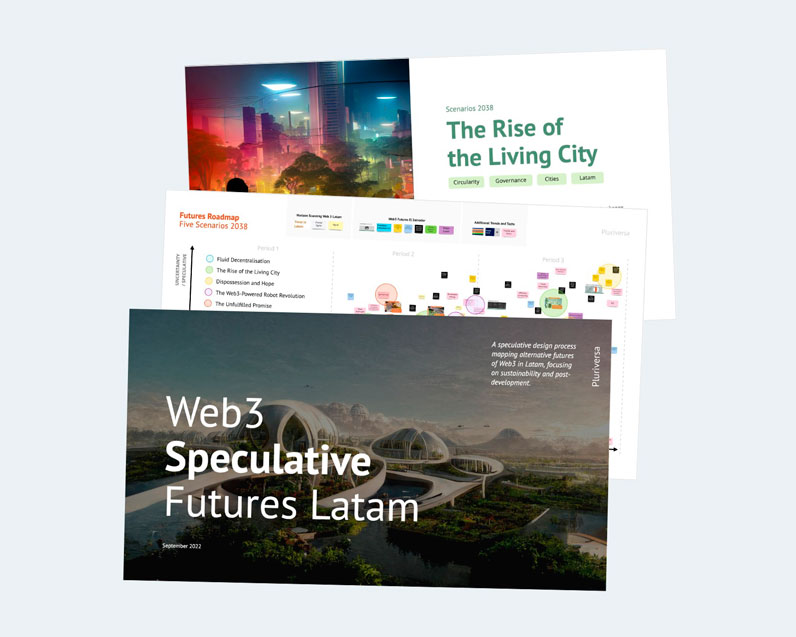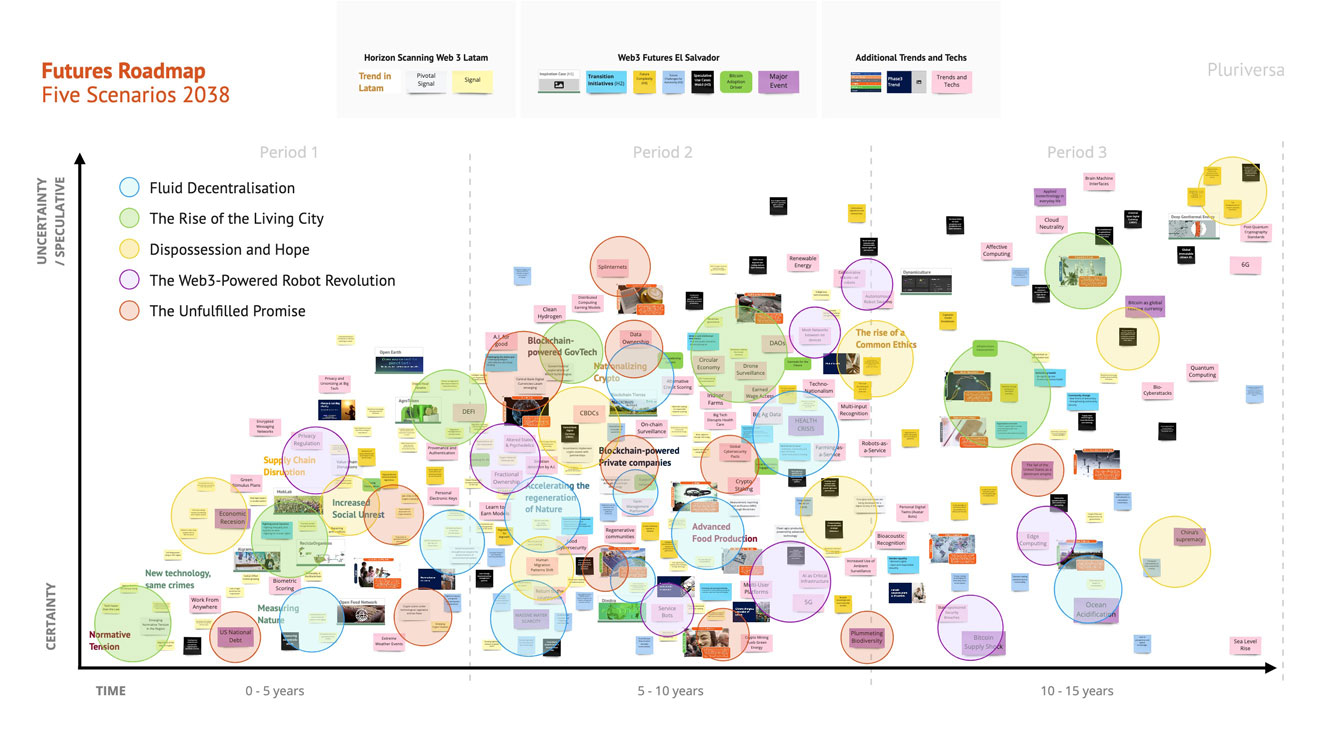Our scenarios
The Rise of the Living City - 2038
Scenario overview
Relational cities in Latin America are helping confront climate change and establish a new form of relating with the environment. This was all possible thanks to a smart contract signed in Lima by some of the region’s megacities. These megacities established a ‘proof-of-circularity’ protocol, moving away from linear economies and towards circular ones. With the help of international cooperation, new forms of governance emerged where citizens had a direct say on important local matters. Similarly, new forms of decentralized finance allowed people to invest in different initiatives, facilitating the flourishing of common goods. However, the implementation of so much technology is not risk-free.
*This scenario was created originally in British English.
-
Web3 Speculative Futures Latam
Sector:
Web3, Bitcoin, Blockchain
Key topics:
Circularity, Governance, Cities, Latam
Time horizon:
2038

The Relational and Convivial City
Latin America is experiencing a boom of relational cities, i.e. cities that are not only facing climate change but also generating systems that relate to the existing and pre-existing life and ecosystems of the territories they are part of.
This movement was made possible by the agreement on Technological Ethics and Autonomous and Regenerative Cities in Lima, Peru, which was signed as a smart contract on Web3 and ratified years later by 15 megacities.
This agreement laid the foundation for transforming cities into true incubators where human life could coexist with nature in symbiotic systems with the surrounding bioregions and with state-of-the-art technology for regeneration. The priority is good living, the autonomy of communities, and the plurality of worldviews of the people who populated the cities on a massive scale through constant internal and external migration.
The rise of progressive left governments in the region gave priority and incentives for people to form decentralized ventures to self-organize and locally manage their services while intelligently connecting with central systems in mutual collaboration, transparency, and remuneration.

Circularity
The 15 megacities within the Lima agreement do not allow linear economies, in other words, the production of any product or service that does not consider waste as part of its value chain.
To comply with international environmental agreements, the cities’ carbon offsets consider the use of waste and eliminate the concept of “rubbish”. A proof-of-circularity blockchain protocol is incorporated, whereby energy generation and other usable materials are recorded and can be verified internationally, involving citizens in composting organic material and decision-making under a zero-waste mantra.
The digitalisation of money, smart contracts, the immutability of the Blockchain, artificial intelligence, and the internet of things allowed these complex systems to be woven together in intricate and ultra-efficient ways. This is the beginning of a truly circular economy at scale.
Plural technology governance
The first autonomous settlements were established through a coordinated effort between international cooperation and municipal governments, where citizens had a say in decisions for the common good. A group of activists and techno-utopians developed the first Decentralised Autonomous City Governments (DAGovs) for the governance of such suburban communities, in which citizens, through a technological platform, not only communicate with each other and with other localities but also participate directly in decision-making.
Such citizen governments function with more representative, participatory, direct and fluid democracy, choosing their governors on the same platform with an immutable record of their proposals and achievements at the end of each term.
In turn, within the DAGovs exists diverse thematic action groups that organise and carry out joint projects; proposals can be selected by open and fair tendering. Contracts are citizen-monitored and audited by any citizen or individual worldwide. International aid flows directly to the thematic groups with decision-making authority in response to the broader community’s needs.
In a recent case, a DAGov thematic action group in Sao Paulo, Brazil, proposed improvements to the waste management procedure for vehicle batteries. The proposal received local community approval, toxic waste expert review, and international funding for implementation, all on a single platform of the local DAGov.
All of this has been possible with the adoption of a tokenised economy. Backed by the various layers of the Bitcoin protocol, this new form of economy enables live governance experiments in which citizens can process their credentials, pay taxes and services, and make decisions that affect their localities in an immediate, immutable and transparent manner.

Finances for Transition
Other Decentralised Citizen Finance (DeCiFis) platforms enabled people inside and outside the city to invest in a wide variety of projects such as clean energy, community transport, waste management, building public green oases, greening buildings, and growing organic food. Thanks to this explosion of new services with an injection of mixed capital from taxpayers and corporate contributors, cities generated a wealth of new jobs, taking their well-being to unprecedented levels.
Trusted community treasury models and automated resource funds are created, allowing capital to flow efficiently and transparently, in addition to decentralized, egalitarian, and community-based cryptographic-key-management systems (CBCKMS). Thus DAGovs have decomposable, share rights and permissions, which allow to distribute segments of access among participants or to monetize sub-segments of governance roles.
These services are controlled by smart contracts that distribute capital across different levels of investor-participants and public funds immediately and transparently. The old centralized financial systems are no longer in total control, still are now more horizontal actors providing services to this distributed network according to the decisions of each locality through DAGovs.
Thus, the economy of the cities flows so that citizens invest constantly and freely in the projects that interest them most, proposed by the thematic action groups within each DAGov.
The CO2 absorption capacity of these nascent green cities means that regeneration benefits the DAGovs’ finances and treasury, as other polluting actors must pay to compensate for their emissions to actors that function as contaminating gas sponges.
City Sensorisation and Green Pollution Control
Through city sensorisation, accurate data flows through the Blockchain publicly. The city revolution and data-driven management have brought megacities to an unprecedented level of environmental control. These innovations can provide early warning of high levels of carbon dioxide, noise, crime, water flow, and the interaction and care of species that have begun to coexist in the city through oases and green roofs.
With so many sensors in the city, cybersecurity is a strategic priority. The 15 megacities of the Lima agreement established a decentralized research unit involving local and foreign experts, former hackers, DAGovs, and municipal governments. This plurality ensures implementing higher standards in cryptography and cybersecurity and counter-intelligence of potential attacks.
Companies must also submit to strict environmental and cybersecurity controls through sensors audited by the government and DAGovs. These metrics feed into publicly available smart contracts and enable anyone to audit penalties for environmental impacts and corporate externalities.
Decentralization has started to gain traction. Due to the high competitiveness of decentralized companies with better worker guarantees and rights, many corporations and multinationals have begun migrating to co-ownership and co-governance models.
Co-production
Another ethical principle to which the cities committed themselves was “Autonomy”, which aims to return the capacity to produce goods and services to the people of a community and neighborhood. Localities that have voted for this program, designed by international cooperation through the DAGovs, have installed advanced factories with robotics and state-of-the-art machinery. The initiatives empower local people to produce clothes, home accessories, energy systems, urban agriculture supplies, furniture, and other items that strengthen creativity and meet local needs.
This concept brought about massive investments in local workshops and factories, in Makerspaces and FabLabs, where manufacturing one’s goods became a form of employment and community building. Levels of drug addiction, alcoholism, and domestic violence quickly dropped with the formulation of these neighborhood spaces.

Oppression
Normative tensions within each megacity and the rise to power of some radical right-wing and authoritarian governments have meant that an oppressive elite has also co-opted these developments.
Such is the case in Mexico City, where the social enhancement through sensorisation installed for the birth of the living city is now used for dictatorial surveillance and indoctrination of citizen behavior through social scoring, in which citizens are evaluated according to their actions. This evaluation is not optional and is the endorsement to enjoy city services, freedom, and financial instruments, which are fed back to the scoring and behavioral history.
It is not clear how this experiment will end up in Latin American megacities, but what is certain is a remarkable advance in human with non-human relationships, the recovery of wildlife, and the mitigation of the most adverse effects of climate change.






